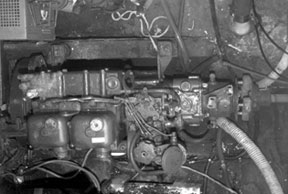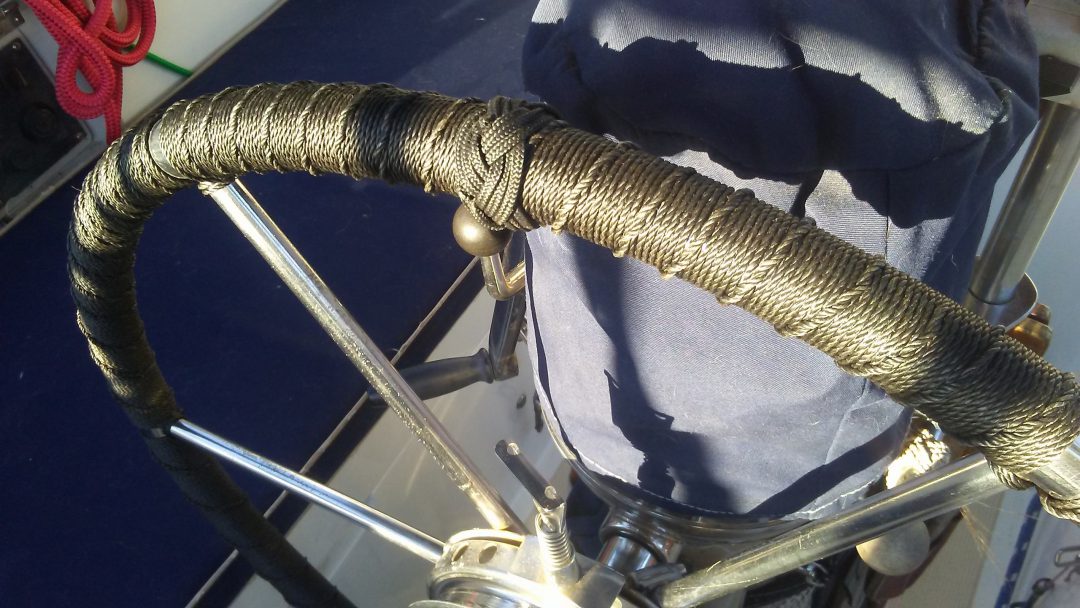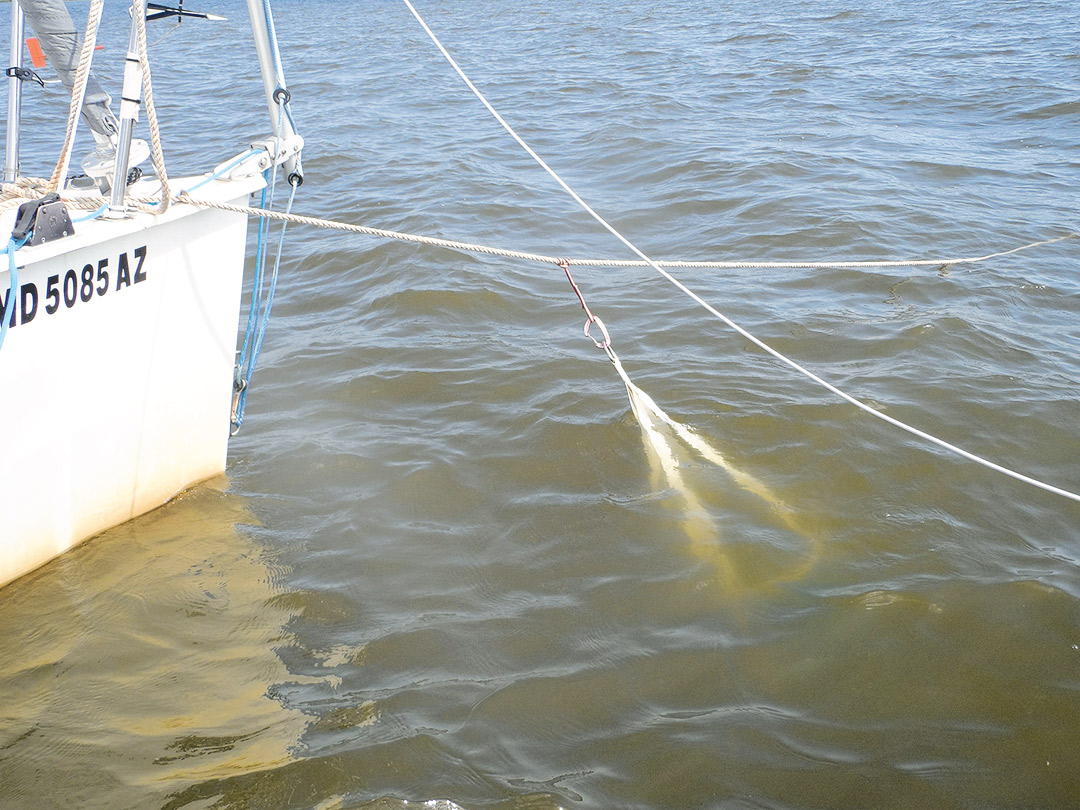
Deployed from the rode, a drogue such as this Seabrake GP24L will slow yawing and reduce the effect of pitching on the anchor.
Yawing on the hook can wreak anchorage havoc. Here’s how to help prevent it.
Issue 138: May/June 2021
A few years ago, while anchored in the snug little harbor of Oxford, Maryland, I witnessed the most spectacular case of sailing at anchor I had ever seen. If not for the lack of sails and forward progress, the boat appeared to be short tacking up the channel.
Back and forth she went, turning 120 degrees at the end of each swing. The bow would come smoothly about, and she would merrily sail 200 feet in the opposite direction. The folks aboard spent the entire night as a floating metronome, swinging steadily to and fro. While they slept, everyone else in the harbor cringed.
The cause? An oversize dinghy on the bow acted like a small sail, encouraging the bow to turn away from the wind, while a fin keel, shallow underbody, and a nylon rode provided minimal damping.
Unfortunately, it’s common to see a boat yawing from side to side at anchor. I say unfortunately, because like pitching (hobby horsing) and surging (fore-aft motion), yawing behavior can reduce the integrity of the anchor set.
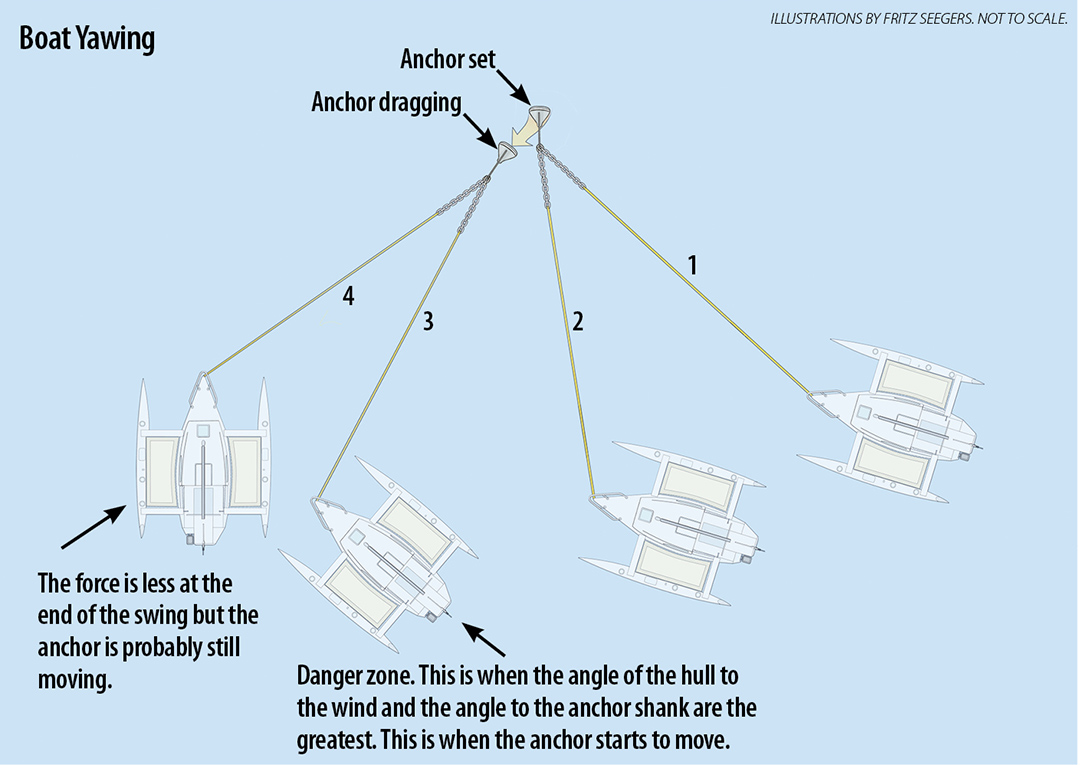
In fact, yawing causes problems on three fronts. First, there is increased windage. When the bow swings to the side, the wind and waves strike the boat from the side, increasing the rode tension dramatically when the yaw angle exceeds 30 degrees.
Second, because yawing causes the boat to sail from side to side, the angle of rode tension also shifts, pulling sideways on the anchor. If the anchor is set in mud, for example, even the slightest wiggle can break the suction that builds around the anchor over time. In sandy bottoms, the same wiggle can reduce soil consolidation. Any anchor that shifts when the boat swings is far more likely to eventually fail.
Finally, there is the jolt that happens when the boat reaches the end of a swing. If the rode is nylon rope, the swing follows a semicircle, and load cell measurements tell us that there is no sudden jolt, only a gradual lessening of force as the bow comes into the wind. But with a chain rode, there can be a second peak of forces when the catenary straightens out with increasing load. If this coincides with a moment when the boat is broadside to the wind and perhaps a gust or a wave strikes, there can be a considerable jolt, many times the static rode tension.
In short, yawing is a big deal. In testing, anchors holding a yawing boat failed in as little as 15 knots of wind after having been previously proven to hold in 60 knots at the same location. If your boat yaws more than about 40 degrees total heading angle, getting the boat to sit still will help more than getting a larger anchor.
What can be done to quiet the nervous boat? The root cause of yawing is a center of wind resistance above the water that is forward of the center of lateral resistance underwater; in other words, an imbalance in center of effort above and below the waterline. It’s best stopped by correcting the imbalance.
Reducing windage forward and adding windage aft helps. Increasing underwater resistance forward and decreasing water resistance aft also helps. In the interest of experimentation, I ditched my usual bridle, secured the rode to the center hull (a surefire way to make a trimaran sail about), and tested some common methods for reducing yawing.
All-Chain Rode
Switching from rope rode to all-chain rode is a good first step to reducing yawing. In light winds, the chain stays relatively motionless on the bottom, and so does the boat on top. As the wind increases, the chain will gradually lift, but even then, the chain encounters resistance as it drags across the bottom.
However, in strong conditions the chain will eventually lift off the bottom, and the all-chain rode loses its advantage in countering yawing forces. At this point, to reduce yawing through the full range of wind speeds, you need to take further steps, including changing the rode attachment (adjusting the bridle), reducing windage (adding a riding sail and minimizing deck equipment), or shifting lateral underwater resistance (lifting foils and/or using a hammerlock mooring).
Windage
A dinghy on the foredeck is one example of how sailors add windage in the worst possible place, the exact opposite of a riding sail. The same goes for furled headsails, even worse if they are on a bowsprit. This is true for any windage forward of the center of lateral resistance, which is typically located just aft of the keel and several feet aft of the mast. To inhibit yawing, do all you can to minimize windage forward.
Lift the Rudder (if you can)
This moves the center of underwater resistance forward and reduces rudder banging. If you have one, keep the centerboard down; this moves the center of resistance forward. Keeping the rudder down and lifting the centerboard will makes things much worse.
Kellet
A weight attached to rope rode imparts a catenary that keeps the rode taut. It also drags on the bottom, like chain. This is a particularly useful trick for boats with a rope rode, as it not only reduces yawing but allows them to swing in synchronization with boats using all-chain in crowded harbors.
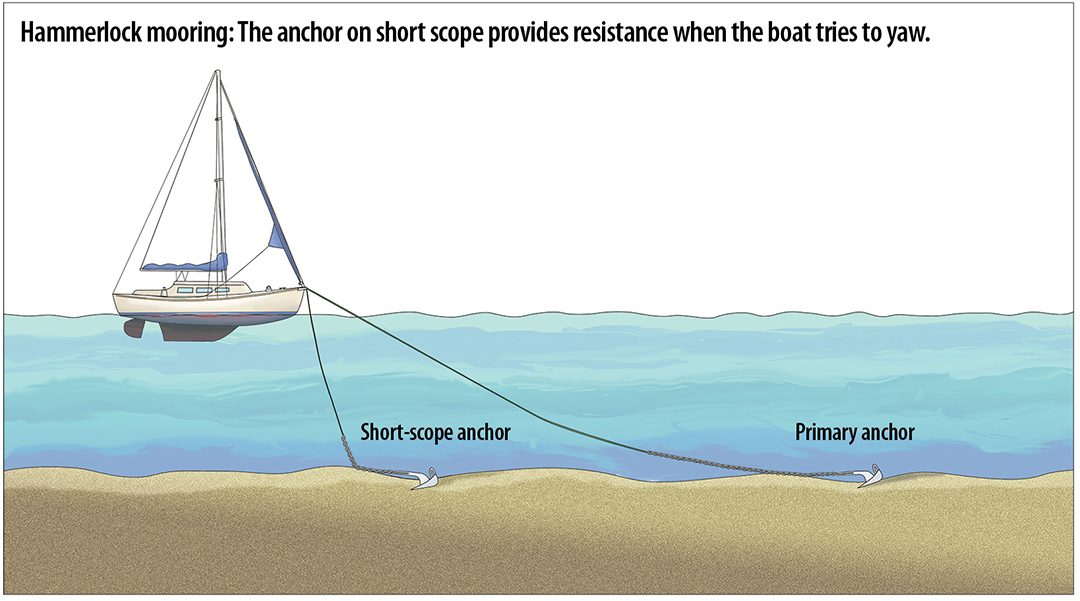
Hammerlock Mooring
This is an old-school method that is fully relevant to today’s nervous boats. Lower a second anchor on 1.25:1 to 1.5:1 scope, preferably of a type that can generate some hold on very short scope (a Bruce or a Lewmar claw is excellent for this because they always dig some, while many others will just skid at ultra-short scope).
For example, a 25-pound claw on 20 feet of line in 10 feet of water (14 feet from the bottom to the deck) is about right for a 35- to 40-foot monohull. It won’t set, but it will provide considerable drag as the bow tries to fall off to one side or the other, stopping yawing before it starts. A kellet can also be used in this way, but a second anchor is more effective and may serve other purposes. In fact, a hammerlock mooring is one of the best uses for the typical double-roller bowsprit; anchor from one, hammerlock from the other. Because of the great difference in scope, tangles are avoided, mostly.
There are downsides. With a reversing tide or in calm winds, the hammerlock mooring can foul the main rode, although this is unusual. Of course, never use a hammerlock mooring where it can cross the rode of another boat; it will snag and probably trip the other anchor, after which things will get very ugly. If the bottom has submerged vegetation or coral, a hammerlock mooring will be destructive. If it works too well, it can pull you out of swing synchronization with other boats in a crowded harbor; in this case, just lift it up until you adjust, and then lower it again.
Bow Drogue
We think of drogues as fabric cones that are trailed behind the boat underway in a gale to reduce speed, improve directional stability, and prevent surfing and broaching. But deployed with short scope from the bow of an anchored boat, a drogue can reduce the speed and range of yawing.
Deploy the drogue with just enough rode (length equal to about three times the freeboard) so that it can pass under the bow during a tack. Weight the tail with just enough chain to keep it in the water, but not so much that it cannot rotate up to the surface when the boat swings.
Cone-shaped fishing drogues work; about 1 inch of diameter for every foot of boat length seems about right. A string of Davis Rocker Stoppers also works. The drogue may also be deployed from the rode, about 10 to 15 feet forward of the bow, where it will also serve to stop vertical movement of the rode (pitching), though you must protect the rode against increased chafe.
Bridle
Multihulls represent the extreme case. When moored at the center alone they are very nervous at anchor, the result of wide beam and shallow keels. If a bridle with legs greater than 120 percent of the beam are attached to outboard bows, a multihull will sit very quietly. Curiously, the bridles fitted on many charter cats are shorter than this, which makes them easier to use on mooring balls (it keeps the ball from banging on the hulls when the wind dies), but less effective at reducing yawing at anchor. Monohulls can also benefit, although the improvement is less dramatic.
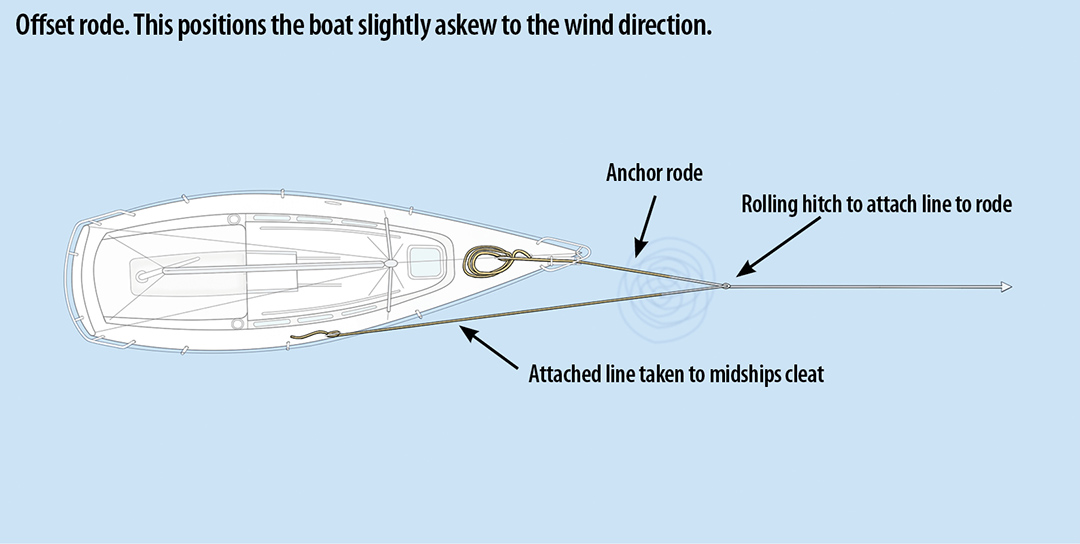
Offset Rode
A bridle reduces yawing by providing two points of support and preventing tacking. On a multihull, this is accomplished with a wide bridle set across the bow, but on a monohull, this is sometimes better accomplished with a bridle built to favor one side. One way to do this is to attach a line to the centerline rode with a rolling hitch and take that line to a midships cleat, pulling the bow to a 10- to 25-degree angle off the wind.
This approach is often used to reduce rolling caused by waves coming from a different direction than the wind, or to mitigate yawing caused by a slight current that is just off one side of the bow (the bow pointing into the wind). However, if the wind varies enough to cause the boat to tack anyway, the offset rode will make the yawing more violent, so be prepared to adjust or to cast it off.
Multiple Anchors
When yawing is caused by wind gusting from varying directions, the only solution may be two anchors set off the bow in a broad V, called a Bahamian Moor. But there are downsides, including increased complexity, potential for tangles, and swinging out of synchronization with other anchored boats.
The anchors do not share the load most of the time, and each anchor must be able to hold the boat on its own. The inside angle of the V should not exceed about 100 degrees, else the force on the anchors will actually be increased in a cross wind.
Tangles caused by the boat spinning with the tide can be prevented by attaching the second anchor with a short rode that terminates at the main rode 6 to 10 feet in front of the roller. When it is time to go, the twists are easily removed by disconnecting the secondary rode. If the second rode extends into a chain locker, the tangles can be epic.
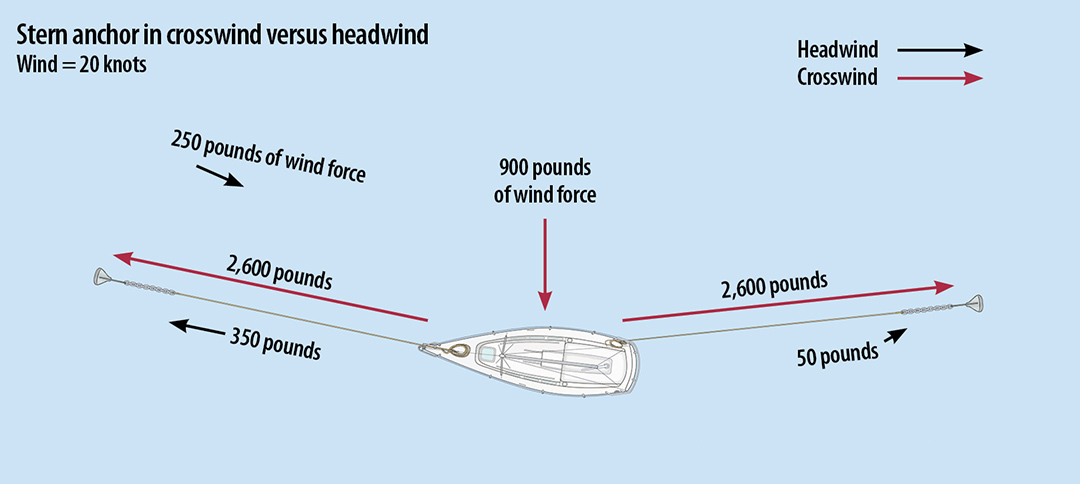
Stern Anchor
If you really do not believe the wind will change direction, anchoring from bow and stern is a simple answer to the yawing problem. Of course, if there are other boats nearby, they will swing, and you will not. Even worse, if the wind switches to the beam, the loads become enormous, the ride becomes rough, and one of the anchors will certainly drag. For these reasons, this option is only useful in narrow, well-protected waterways.
Riding Sails
If the other methods don’t work, try a riding sail. Sailrite sells kits to make them. The FinnDelta from Banner Bay Marine is an example that has done well in independent testing. However, a riding sail will add significant windage and must be set very tight in a blow. And, consider that if your yawing boat is a cruising boat with a dodger and a dinghy on davits, windage balance probably isn’t the problem.
Sailors will spend fruitless hours arguing over whether a 30-pound or 45-pound anchor is large enough, when in fact, the difference in holding capacity between a boat that sits quietly and one that yaws can be twice that. She needs to sit still.
The case for a Dynema Bridle
Heresy, you say. Anchoring bridles are always made from nylon, to absorb gusts and wave impacts. That is unarguably true if the rode is all-chain, but what if the rode is nylon, and there is already plenty of stretch?
I tested double-braid nylon anchor line, polyester yacht double-braid, and Dyneema bridles on my Corsair F-24 trimaran. In lighter winds, I could discern no difference. But when the wind piped up to 25 knots, the nylon bridle stretched as much as 10 percent under load, particularly if a gust caught it from the side, placing up to 300 pounds of stress on a single leg. Because only one leg stretches when yawing, the attachment angle to the boat changes by as much as 17 degrees and yawing increases. Conversely, a non-stretch bridle keeps attachment angle constant.
I now use a Dyneema bridle on my F-24. It is UV resistant, strong, and lighter and smaller than a polyester bridle, which allows me to leave it permanently rigged, a significant benefit, since crawling out on the narrow bows of a trimaran in waves is a bit tricky.
But how do I attach this bridle to a fiber rope? Easy. I use a sewn Dyneema climbing sling ($8) and tie a Prusik knot around the rode. Then I attach the sling to the bridle using carabiners (non-locking wire gate is fine). As a backup, I always cleat the tail of the rode and secure the bitter end in the anchor well. The hitch will hold a minimum of 1,500 pounds before slipping, safe enough for boats up to 35 feet up to 60 knots. If you have a larger boat or like a belt-and-braces approach, use two slings, making sure the load is evenly distributed between them.
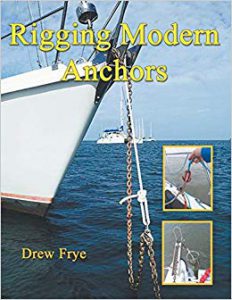
The Full Skinny
For a detailed exploration of anchoring, read Drew Frye’s Rigging Modern Anchors. The book includes clear and comprehensive explanations of all aspects of anchor rigging. No regurgitated salty advice, only things the author could test. Available in print or e-book from Amazon.
Good Old Boat Technical Editor Drew Frye draws on his training as a chemical engineer and pastimes of climbing and sailing to solve boat problems. He cruises Chesapeake Bay and the mid-Atlantic coast in his Corsair F-24 trimaran, Fast and Furry-ous, using its shoal draft to venture into less-explored waters. He is most recently author of Rigging Mod¬ern Anchors (2018, Seaworthy Publications).
Thank you to Sailrite Enterprises, Inc., for providing free access to back issues of Good Old Boat through intellectual property rights. Sailrite.com


